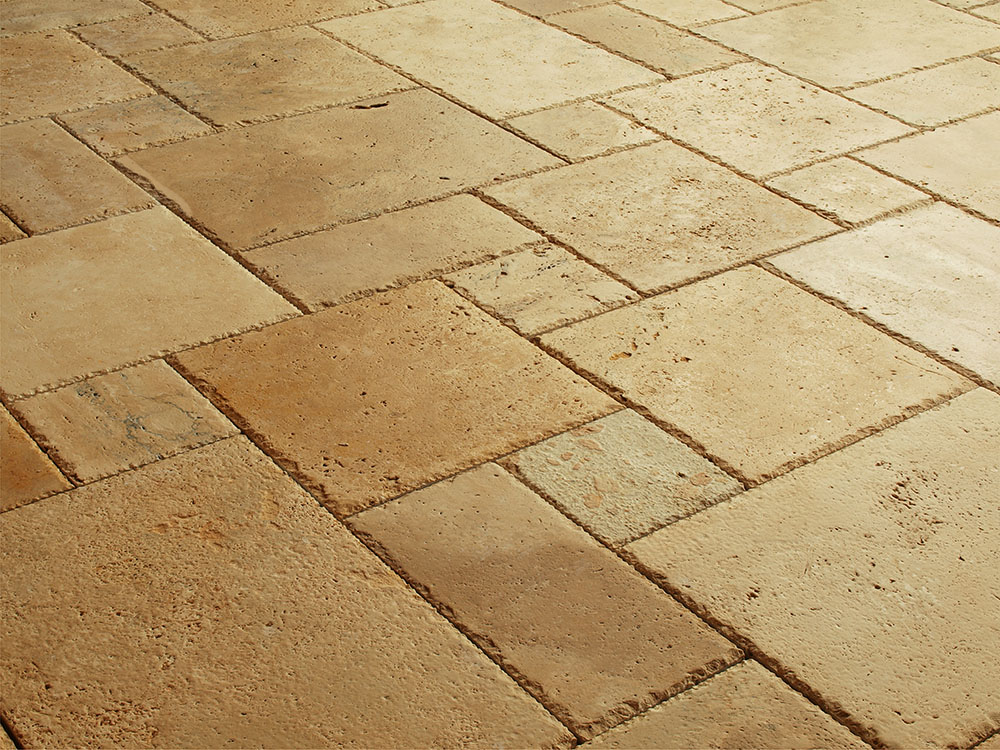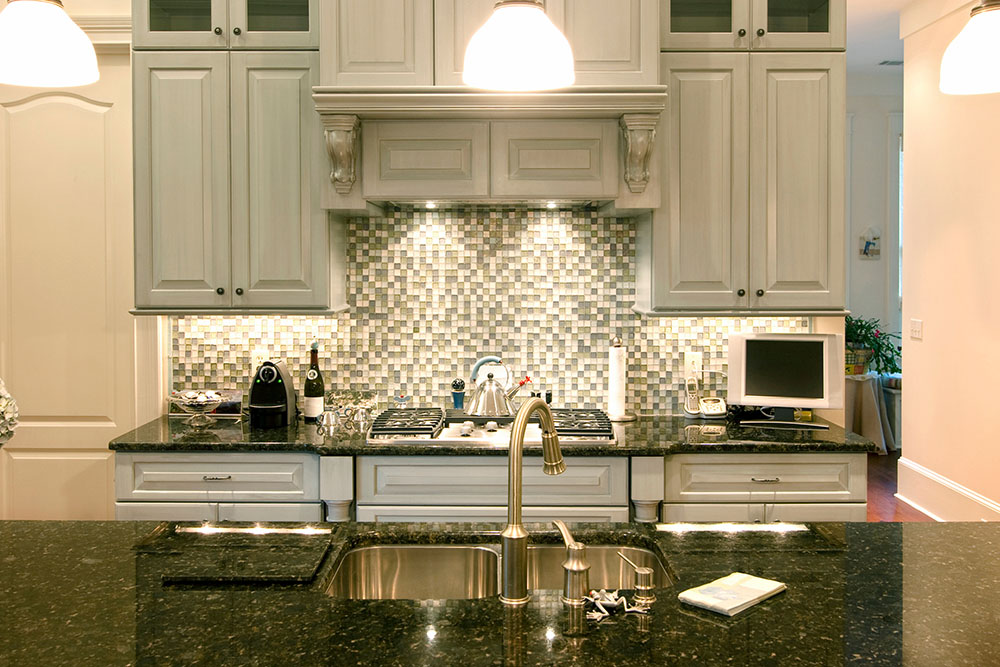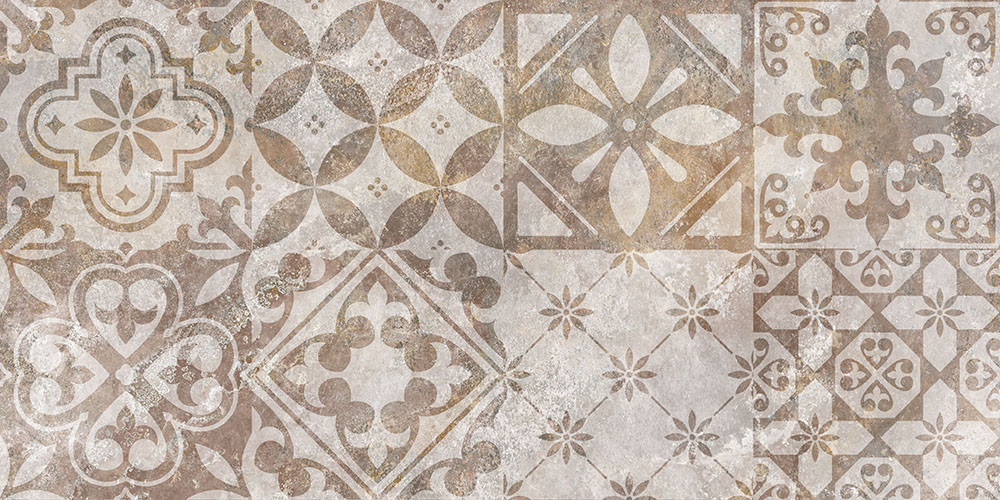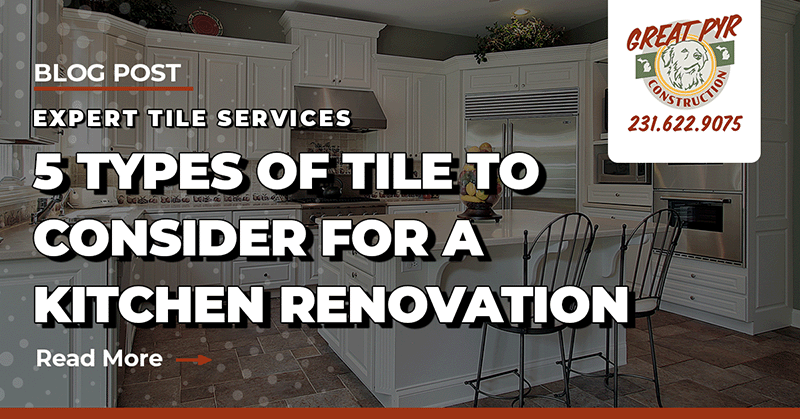When remodeling a kitchen, choosing the right tile can completely transform the space — both in style and function. From durable flooring options to stunning backsplashes, tile plays a crucial role in creating a kitchen that’s beautiful, practical, and built to last.
Whether you’re designing a cozy cottage kitchen or a luxurious chef’s space in Northern Michigan, the right tile selection will help tie everything together.
Below, we explore five types of tile homeowners should consider for their kitchen remodel — including key features, pros and cons, and what you might expect to pay for each material.
Remodeling your bathroom instead? Check out the 5 types of tile to consider for a bathroom renovation here, and if you need help with either kind of renovation, visit our Contact page to reach out!
Porcelain Tile

Key Features of Porcelain Tile
Porcelain is one of the most durable tile materials available, making it ideal for kitchen floors. Fired at high temperatures, it’s dense, water-resistant, and available in countless styles — including wood-look, stone-look, and polished finishes. Many high-end kitchens use porcelain for both floors and accent walls.
Benefits
- Exceptional Durability: Withstands heavy foot traffic, dropped utensils, and moisture.
- Low Maintenance: Glazed porcelain resists stains and cleans easily with regular mopping.
- Design Versatility: Available in wide ranges of colors, patterns, and even large-format tiles.
- Perfect for Heated Floors: Conducts heat efficiently if installing radiant flooring.
Drawbacks
- Hard Underfoot: Can feel cold and rigid without radiant heat.
- Installation Challenges: Requires professional-grade tools and expertise for proper cuts and fitting.
Cost Expectations
Expect to pay $3–$12 per square foot for porcelain tile materials, with higher-end styles reaching $20+.
Ceramic Tile

Key Features of Ceramic Tile
Ceramic tile remains a kitchen classic. Made from natural clay and finished with a glaze, ceramic is perfect for backsplashes, walls, and even light-traffic kitchen floors. Its broad design range makes it a favorite for homeowners wanting custom looks without a luxury price tag.
Benefits
- Affordable: Budget-friendly material with a premium appearance.
- Color Variety: Thousands of colors, patterns, and textures available.
- Easy to Work With: Softer than porcelain, making installation less labor-intensive.
Drawbacks
- Lower Durability: Softer than porcelain and prone to chipping under heavy use if not installed carefully.
- Water Sensitivity: Unglazed ceramic must be sealed to prevent moisture absorption.
Cost Expectations
Basic ceramic tiles start around $1–$5 per square foot, with artisan and specialty ceramics costing more.
Natural Stone Tile (Marble, Slate, Granite)

Key Features of Natural Stone Tile
Natural stone adds organic elegance to kitchen designs. Popular choices like marble, slate, and granite offer unique veining, rich textures, and timeless luxury. Stone tiles are typically used for high-end floors, accent walls, and backsplashes in luxury kitchens.
Benefits
- Unmatched Beauty: No two natural stone tiles are exactly alike.
- Long-Term Investment: Properly maintained stone flooring can last a lifetime.
- Radiant Heat Compatibility: Stone holds and radiates warmth beautifully with heated floors.
Drawbacks
- Needs Sealing: Most stones are porous and require regular sealing to resist stains.
- Higher Cost: Material and installation are more expensive than ceramic or porcelain.
Cost Expectations
Natural stone tile ranges from $7–$30+ per square foot, depending on the material and finish.
Glass Tile

Key Features of Glass Tile
Glass tile brings vibrant color and shimmering elegance to kitchen backsplashes. It reflects light beautifully, making smaller kitchens appear brighter and more spacious. Glass tiles come in sheets or mosaics for easy installation.
Benefits
- Visual Impact: Bold color and shine immediately modernize kitchen designs.
- Stain Resistance: Non-porous surface resists grease and food splashes.
- Eco-Friendly Options: Many glass tiles are made from recycled materials.
Drawbacks
- Fragile During Installation: Glass can crack if mishandled, requiring a skilled installer.
- Fingerprints and Smudges: Shows grease more readily than ceramic or porcelain.
Cost Expectations
Glass tiles range from $7–$20 per square foot, depending on size and complexity.
Cement Tile

Key Features of Cement Tile
Cement tiles, also called encaustic tiles, are handmade using mineral pigments and hydraulic presses. Known for their vibrant patterns and matte finishes, they bring personality to kitchen floors, walls, or islands. They’re especially popular in artisan, Mediterranean, or vintage-style kitchens.
Benefits
- Artistic Style: Intricate, colorful designs make a bold statement.
- Durability: With proper sealing, cement tile can handle daily kitchen wear.
- Eco-Friendly: Made using natural materials without high-energy firing.
Drawbacks
- Requires Sealing: Cement is porous and needs sealing before and after grouting.
- Maintenance Needs: Regular resealing is necessary to prevent stains.
Cost Expectations
Cement tile costs around $9–$18 per square foot, plus sealing and specialty installation labor.
Ready to Upgrade Your Kitchen with Beautiful Tile?
Whether you dream of a timeless stone floor, a vibrant mosaic backsplash, or a sleek porcelain surface, Great Pyr Construction can help bring your kitchen vision to life. Our team has years of experience installing durable, luxurious tilework across Northern Michigan homes.
Contact us today for a free kitchen consultation, and let’s transform your space with expert tile installation!


Comments (2)
mo7qy4
h7usa9